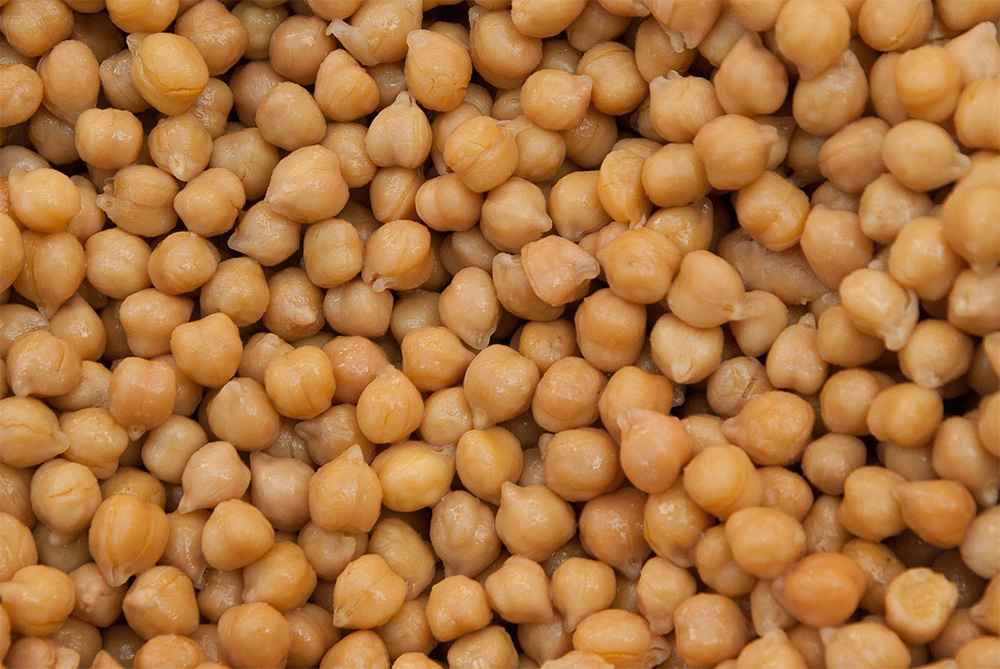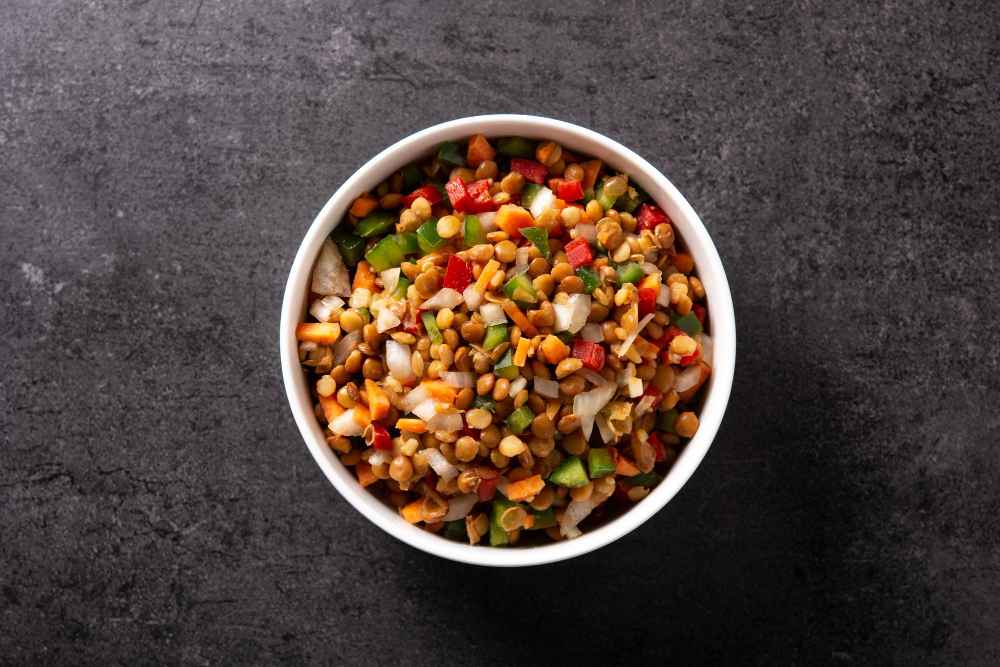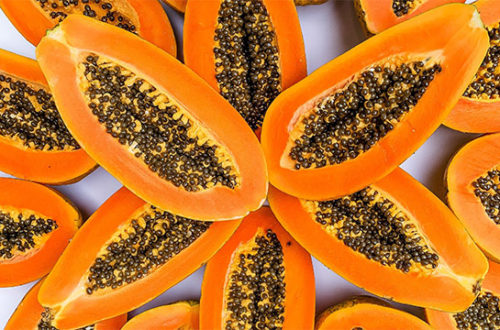
Health Benefits of Chickpeas and their Nutrition value
The chickpea (Cicer arietinum L.) is a major grain legume cultivated for its edible seeds in the Mediterranean Basin, Asia, and Australia. There are a lot of health benefits of chickpeas that we’ll cover in this article. It is also known as garbanzo beans, chickpeas come from the legume family. They are large and roundish legumes with bumpy textures.
Chickpeas are classified into two main commercial seed types: desi, and kabuli. Chickpeas are one of the oldest consumed varieties of legumes on the planet. In fact, they have been a prominent part of traditional diets for more than 7,500 years. Even today, chickpeas are incorporated into daily diets and recipes in healthy populations across the globe.
Nutritional value
Chickpeas are one of the most popular types of legumes. They’re incorporated into the diets of some of the healthiest people in the world.
Chickpeas are bursting with numerous antioxidants, minerals, nutrients, and vitamins (including magnesium, folate, vitamin C, calcium, zinc, phosphorous, vitamin B6, and potassium), which provide comprehensive health benefits of chickpeas to our daily life.
Chickpeas, also known as garbanzo beans, are a nutrient-rich legume that offers a variety of health benefits. Here are the approximate nutritional facts for 1 cup (164 grams) of cooked chickpeas:
- Calories: 269
- Protein: 14.5 grams
- Carbohydrates: 45 grams
- Dietary Fiber: 12.5 grams
- Sugars: 8 grams
- Fat: 4.2 grams
- Saturated Fat: 0.4 grams
- Monounsaturated Fat: 1.1 grams
- Polyunsaturated Fat: 1.5 grams
- Vitamin A: 7% of the Daily Value (DV)
- Vitamin C: 6% of the DV
- Vitamin K: 26% of the DV
- Thiamin (Vitamin B1): 14% of the DV
- Riboflavin (Vitamin B2): 6% of the DV
- Niacin (Vitamin B3): 5% of the DV
- Vitamin B6: 10% of the DV
- Folate (Vitamin B9): 71% of the DV
- Pantothenic Acid (Vitamin B5): 7% of the DV
- Calcium: 6% of the DV
- Iron: 26% of the DV
- Magnesium: 15% of the DV
- Phosphorus: 28% of the DV
- Potassium: 14% of the DV
- Zinc: 17% of the DV
- Copper: 29% of the DV
- Manganese: 84% of the DV
- Selenium: 9% of the DV
Keep in mind that these nutritional values are approximate and can vary based on factors such as cooking method and portion size.
Chickpeas are rich in a variety of nutrients that are vital for maintaining good health. Here’s a breakdown of their nutritional content:
Protein
Chickpeas can give you about 15 grams of pure protein per ½ cup. These are excellent sources of plant-based protein, making them a valuable option for vegetarians and vegans. You can cook them, steam them, or fry them in olive oil. Just make sure you also eat foods with amino acids (e.g., eggs). Protein is essential for the repair and growth of tissues, as well as the production of enzymes and hormones (Trusted Source).
A protein deficiency can lead to several problems, including muscle exhaustion, fatigue, cataracts, cardiovascular disorders, poor skin health, and inadequate hormone production. Compared with other plant foods chickpeas are higher in protein and contain important minerals such as iron and zinc (Trusted Source).
Fiber
High in dietary fiber, chickpeas support the digestive health benefits of chickpeas by promoting regular bowel movements, preventing constipation, and supporting a healthy gut microbiome. The higher amounts of dietary fiber and protein content of chickpeas, and possibly the presence of enzyme inhibitors and “antinutrients” such as tannins present in chickpeas. Fiber also aids in maintaining healthy blood sugar levels and reducing the risk of heart disease (Trusted Source).
Vitamins
Chickpeas are a good source of various vitamins, including vitamin K, vitamin C, vitamin B6, and folate. The improvement in vitamin retention by microwave cooking may have been the result of shorter cooking time compared to boiling and autoclaving (Trusted Source).
Chickpeas contain different vitamins, minerals, and several bioactive constituents (phenolics, phytates, enzyme inhibitors, and oligosaccharides) that could help to reduce the risk of chronic diseases. These vitamins play essential roles in blood clotting, immune function, brain health, and cell division.
Complex Carbohydrates
The main energy provided by chickpeas in the human diet and animal feed is derived from carbohydrates, which constitute 51% – 65% of desi and 54% – 71% of Kabuli seed weight. The health benefits of chickpeas provide complex carbohydrates that are slowly digested, leading to a gradual release of energy and preventing rapid spikes in blood sugar levels. Chickpea is a good source of carbohydrates and protein, which are predominantly stored in the cotyledons (Trusted Source).
Minerals
Legumes are a good source of minerals that are essential for growth and development. They are rich in minerals such as iron, magnesium, phosphorus, and zinc. Mg, Mn, Zn, Fe, and Cu were determined using an atomic absorption spectrophotometer. These minerals are crucial for maintaining healthy bones, supporting the immune system, and aiding in various metabolic processes (Trusted Source).
Health Benefits of Chickpeas
They help with digestion
Chickpeas are high in dietary fiber, especially a soluble fiber called raffinose. The high fiber content of chickpeas promotes healthy digestion by preventing constipation and supporting a balanced gut microbiome. The benefits of chickpeas are the good bacteria in your gut break this down so your colon can digest it slowly. This can contribute to improved nutrient absorption and overall digestive comfort (Trusted Source). Studies have found that eating more chickpeas can help make bowel movements easier and more regular.
Chickpeas help control blood sugar
The fiber and protein in chickpeas slow down the digestion process, preventing rapid spikes in blood sugar levels. Canned and dried chickpeas have a low glycemic index. This means your body absorbs and digests them slowly. Also, they have a type of starch that digests slowly, called amylose (Trusted Source).
Both of these things help keep your blood sugar and insulin from going up too fast. This is particularly beneficial for individuals with diabetes or those at risk of developing diabetes.
They give you stronger bones
The minerals, such as calcium, magnesium, and phosphorus, found in chickpeas are essential for maintaining strong and healthy bones. But be sure to soak them first to get rid of things called phytates, which can get in the way of your body absorbing the calcium in chickpeas (Trusted Source). This is particularly important for preventing osteoporosis and fractures, especially in older individuals.
They could boost your mental health
The vitamins and minerals present in chickpeas, including magnesium and vitamin B6, play a role in supporting brain health and cognitive function (Trusted Source).
Chickpeas have choline, a nutrient that helps make important chemicals for memory, mood, muscle control, and other brain and nervous system activity.
Help Lose Weight
The combination of protein, fiber, and low glycemic index makes chickpeas a satisfying and nourishing food choice. The fiber makes this very obvious. It is going to make you feel full for long periods. And that is going to help you stay away from junk food and other useless stuff. In fact, chickpeas might also help cut body fat – contributing to weight loss (Trusted Source).
Another nutrient we must talk about is protein, which is known to regulate weight. Studies showed that subjects on high protein not only lost body weight but were also able to shed more body fat. Also, the protein’s thermic effect is 30 percent. This means that you will burn 30 percent of the calories during the digestion of protein.
Improved Gut Health
Chickpeas are an excellent source of dietary fiber, both soluble and insoluble. The soluble fiber in chickpeas provides nourishment for beneficial gut bacteria, promoting a balanced and diverse gut microbiome. A healthy gut microbiome is associated with improved immune function and overall well-being. Insoluble fiber adds bulk to stool and supports regular bowel movements (Trusted Source).
Antioxidant Properties
Chickpeas contain various antioxidants, including flavonoids and polyphenols, which help combat oxidative stress and reduce the risk of chronic diseases. Antioxidants help neutralize harmful free radicals in the body, which can contribute to chronic inflammation and weaken the immune system over time. Chickpeas also contain Vitamin C which helps neutralize free radicals and supports the immune system (Trusted Source).
Improved Immune Function
Chickpeas’ nutrient content, including vitamins and minerals like zinc and selenium, supports a healthy immune system, helping the body fight off infections and illnesses. They can contribute to improved immune function due to their rich nutrient content. While they may not have direct, miraculous effects on the immune system, their nutritional components can certainly support overall immune health.
Contain Starch
The starch in chickpeas is slow-burning. Chickpeas are a good source of dietary starch, and they provide various nutrients, including protein, dietary fiber, vitamins, and minerals.
In other words, your body won’t quickly break it down and convert it into glucose — which spikes your blood sugar. The starch content in chickpeas can contribute to their nutritional profile and energy content. Unlike the sugar content found in pasta, processed foods, refined flour, white bread, and soda, the starch in chickpeas takes a good amount of time to break down.
Chickpeas and Cancer
The antioxidants and phytochemicals in chickpeas, particularly saponins, have been studied for their potential anti-cancer effects ( Trusted Source ). Moreover, eating chickpeas on a regular basis may help reduce the chance of developing symptoms of cancer. They’re instrumental in keeping the digestive system clean, healthy, and free from all sorts of toxins and bad bacteria.
These compounds may help inhibit the growth of cancer cells and reduce the risk of certain types of cancers. They promote the growth of healthy bacteria by balancing the body’s pH levels, which significantly minimizes inflammation.
Help Boost Alkalinity
It’s important to realize that legumes have alkalizing properties. Alkalinity helps the body balance its pH levels. The pH scale ranges from 0 to 14, with 7 being neutral. Anything below 7 is considered acidic, while anything above 7 is considered alkaline ( Trusted Source ).
Chickpeas have a pH that is slightly above 7, typically ranging from 7.1 to 7.4, making them mildly alkaline. It’s important to note that the alkalinity or acidity of foods doesn’t necessarily directly affect the pH of your body. The more balanced these levels are, the less you have to worry about toxic build-up.
benefits of chickpeas Eliminate Wrinkles
Manganese also enhances skin health and reduces fine lines and wrinkles. Wrinkles are primarily caused by factors such as aging, sun exposure, genetics, and lifestyle choices. As a matter of fact, manganese is used to manufacture a majority of beauty products. Chickpeas are loaded with antioxidants, including manganese, vitamins A, C, and E, as well as various phytonutrients.
Essentially, manganese helps your skin generate the necessary energy to combat a free-radical infestation that causes wrinkles and lines in the first place ( Trusted Source ). Antioxidants help combat free radicals, which are unstable molecules that can damage skin cells and contribute to premature aging, including wrinkles.
Source of Dietary Iron
Benefits of chickpeas are a good source of non-heme iron, which is the type of iron found in plant-based foods. A single cup full of chickpeas contains around 4.7 mg of iron ( Trusted Source ). Iron is one of the most important nutrients in the human body. An iron deficiency can lead to a plethora of health problems (the most common of which is anemia). Anemia prevents your body from producing a healthy amount of red blood cells.
Keep in mind that iron absorption from plant-based sources like chickpeas can be influenced by other factors in your diet, such as the presence of vitamin C and phytates. In addition, anemia can cause other health issues (such as hair loss and brittle nails).
Chickpeas and Artery Health benefits
Fiber helps make a gel-like component inside your digestive tract. The health benefits of chickpeas are naturally low in saturated fat, which is a type of fat that can contribute to the buildup of plaque in the arteries. Soluble fiber can help lower levels of LDL (“bad”) cholesterol in the blood, which is beneficial for heart health Soluble and insoluble fibers have been identified as major nutrients ( Trusted source ).
On top of that, chickpeas help keep your arteries free from plaque, which in turn keeps your blood- pressure levels in check ( Trusted Source ).
Chickpeas have a relatively low glycemic index (GI), which means they have a slower impact on blood sugar levels. Stable blood sugar levels are important for maintaining overall cardiovascular health. Maintaining your blood pressure can greatly minimize the chances of suffering a stroke or heart attack.
Chickpeas and Vitamin C
Chickpeas contain a small amount of vitamin C. Although vitamin C is more commonly found in Vitamin C is primarily found in fruits like oranges, grapefruits, lemons, and limes, as well as in other fruits like strawberries, kiwi, and papaya.
You can get around 3.8 grams of vitamin C per 100 grams of chickpeas. Vitamin C is a great way to maintain your blood vessels, have clear skin, and maintain the health of your muscle tissue ( Trusted source ). While men require a daily value of 90 mg of vitamin C, women require 75 mg. They may contribute a small amount of vitamin C to your diet, if you’re looking to increase your vitamin C intake, it’s better to focus on consuming fruits and vegetables.
Benefits of Chickpeas Protect Your Vision
Chickpeas contain beta-carotene, a precursor to vitamin A. Beta-carotene has countless benefits, including eye health. Legumes, chickpeas, in particular, have tons of the stuff. Vitamin A is essential for maintaining good vision, especially low-light and night vision ( Trusted source ). Make a bowl of veggies packed with beta-carotene for a clearer look at life.
May Lower Inflammation
Choline in chickpeas is a macronutrient that might play a vital role in the body’s ability to fight chronic inflammation which is linked to various chronic diseases such as heart disease, diabetes, and arthritis ( Trusted source ). It may also regulate your sleep cycle, increase the range of movement in the muscles, as well as boost learning and memory.
Varieties of chickpeas
There are two primary varieties of chickpeas, ‘Kabuli’ and ‘desi.’ Both names originated in Northern India. Smaller chickpeas are known as desi ( Trusted source ). They’re dark and yellow on the inside. Kabuli is the traditional whitish-beige chickpeas, which are more popular throughout the world.
Furthermore, the Apulian black is another chickpea type, less common, which has peculiar phenotypic and genetic features and is the object of increasing attention by geneticists to avoid the risk of genetic erosion. However, the majority of these studies concerned the kabuli chickpeas, which are commonly used for processed products, whereas fewer studies have evaluated the desi chickpeas and no studies have been carried out on Apulian black chickpeas.
Bengal Gram (Black Chickpeas)
The Bengal gram chickpeas are grown in India. Most people say its name is kala chana or Bengal Gram. There, farmers sun-dry the vegetables, which changes their color to a deep, rust-like color. But the taste doesn’t really change. Health benefits of chickpeas to use in a chana chaat which is a nutrition-packed chickpeas salad with black chana. They still have the same nutty taste and aroma that you’d get from traditional chickpeas.

Chana
These chickpeas resemble yellow split peas. Mostly cultivated in India, they have a sweet aroma and a nutty taste, and they’re utilized for making chickpea flour.
Chickpea Shoots
These shoots are seasonal, and they can sometimes be found in your local farmer’s market. Their feathery shoots are harvested from the chickpea plant, and they can be used to make a salad.
Green Chickpeas
These delicious, sweet, fresh chickpeas are harvested young and tender. They’re quite common in almost every part of the globe.
Potential Considerations
Digestive Sensitivity
Some individuals may experience digestive discomfort when consuming chickpeas due to their fiber content. Eating large amounts of chickpeas in one sitting can overwhelm the digestive system, especially if you’re not accustomed to consuming high-fiber foods. Gradually increasing intake and proper cooking can help reduce these issues.
Flatulence
Chickpeas can lead to gas production in some individuals due to their oligosaccharide content. Soaking dried chickpeas before cooking can help reduce their gas-producing compounds. Also soaking and rinsing dried chickpeas before cooking can help alleviate this issue.
Allergies
Chickpea allergies are rare but can occur. If you experience allergic reactions such as itching, swelling, or difficulty breathing after consuming chickpeas, seek medical attention. Symptoms may include swelling of the face or throat, difficulty breathing, a rapid drop in blood pressure, and loss of consciousness.
Anti-nutrients
Benefits of chickpeas contain compounds like phytic acid that can inhibit the absorption of certain minerals. Phytates can bind to minerals such as iron, zinc, calcium, and magnesium in the digestive tract, reducing their absorption. Soaking, sprouting, or cooking can help reduce the levels of these anti-nutrients.
Conclusion
Chickpeas are a nutritional powerhouse that offers an array of health benefits, ranging from heart health to weight management and beyond. All in all, chickpeas are a wonderful source of a plethora of daily and essential vitamins, minerals, and protein. And they’re budget-friendly, tasty, and easily available. Their rich nutritional profile, versatile culinary uses, and potential disease-fighting properties make them a valuable addition to a balanced and wholesome diet.
Whether you’re looking to improve your digestive health, support your heart, or simply enjoy a delicious and nutritious meal. So, go ahead and explore the many ways you can incorporate these tiny legumes into your diet and reap the rewards of their health-promoting properties.






2 Comments
tempmail
Hello i think that i saw you visited my weblog so i came to Return the favore Im trying to find things to improve my web siteI suppose its ok to use some of your ideas
fitspresso customer reviews
Your writing is so eloquent and engaging You have a gift for connecting with your readers and making us feel understood